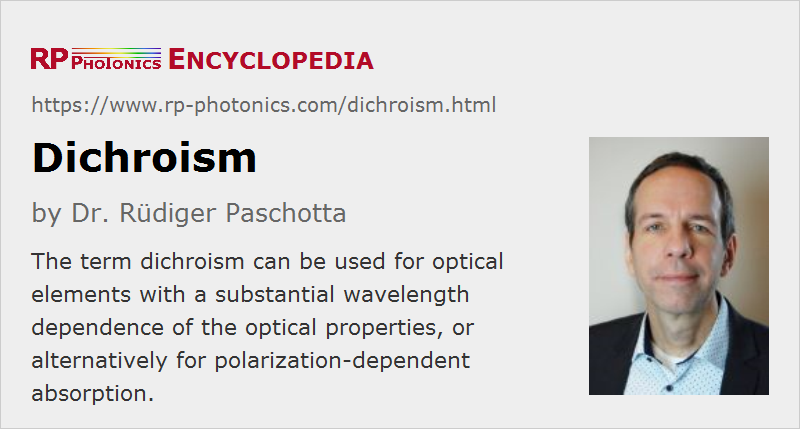Dichroism
Definition: wavelength-dependent transmission, alternatively polarization-dependent absorption
Alternative term: diattenuation
German: Dichroismus
Author: Dr. Rüdiger Paschotta
Cite the article using its DOI: https://doi.org/10.61835/2gi
Get citation code: Endnote (RIS) BibTex plain textHTML
The term dichroism (with the corresponding adjective dichroic) is used with two different meanings, explained in the following sections.
Wavelength-dependent Transmission
The term can be used for optical elements which somehow act on light with a substantial dependence on the optical wavelength. In particular, the transmissivity can be wavelength-dependent. The term is particularly used in conjunction with dielectric mirrors; see the article on dichroic mirrors.
Polarization- and Wavelength-dependent Absorption
Dichroism can also mean the polarization-dependent absorption of materials; the term diattenuation can also be used as long as linear polarization is involved. That use of the term dichroism may seem odd at a first glance, since from the word one would normally expect that the dependence is on wavelength (color) rather than polarization. However, certain crystal materials (e.g. tourmaline, where the effect was originally observed) appear with different colors, depending on the polarization of illumination, since their optical absorption (and consequently also their reflectance) depends both on polarization and wavelength. (The wavelength dependence essentially results from the fact that the band gap energy depends on the propagation direction.) Of course, there are not only two different possible colors, as the term might suggest, but rather a continuum of color mixtures for intermediate polarization directions.
Note that there is also the phenomenon of trichroism, observed on biaxial crystals. They are, the observed colors are mixtures of three rather than two different colors.
Polarization-dependent absorption is used for some kinds of optical polarizers, namely for sheet polarizers based on polymer films. For such applications, the films may be optimized for minimum wavelength dependence, and the term dichroism may then be regarded as somewhat inappropriate.
Linear and Circular Dichroism
Dichroism is in most cases related to linear polarization directions, but there is also circular dichroism, where the difference in optical properties occurs for different circular polarization directions.
More to Learn
Encyclopedia articles:
Questions and Comments from Users
Here you can submit questions and comments. As far as they get accepted by the author, they will appear above this paragraph together with the author’s answer. The author will decide on acceptance based on certain criteria. Essentially, the issue must be of sufficiently broad interest.
Please do not enter personal data here; we would otherwise delete it soon. (See also our privacy declaration.) If you wish to receive personal feedback or consultancy from the author, please contact him, e.g. via e-mail.
By submitting the information, you give your consent to the potential publication of your inputs on our website according to our rules. (If you later retract your consent, we will delete those inputs.) As your inputs are first reviewed by the author, they may be published with some delay.

 general optics
general optics

2020-06-15
What is the difference between gain dichroism and gain anisotropy?
The author's answer:
I think it means the same, only that the first term is not common.